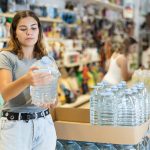What’s lurking in your water? Research unveils troubling findings
 (NaturalHealth365) In 2024, nanoplastics have become an ever-present menace. They stealthily infiltrate food, drinks, and every aspect of daily life, permeating our bloodstream and vital organs.
(NaturalHealth365) In 2024, nanoplastics have become an ever-present menace. They stealthily infiltrate food, drinks, and every aspect of daily life, permeating our bloodstream and vital organs.
A chilling report published in Proceedings of the National Academy of Sciences (PNAS) exposes the alarming reality: bottled water, often falsely thought of as “pristine,” is (in many cases) contaminated with these minuscule plastic intruders.
How scientists identified small pieces of plastic in bottled water
Researchers conducted an extensive examination of bottled water sourced from three prominent brands available at a major “big box” retail outlet. Employing a unique technique known as Stimulated Raman scattering (SRS) microscopy, they delved into the microscopic realm to scrutinize the composition of water particles.
Despite variations in the precise chemical makeup of nanoplastics among the different brands, the analysis uncovered a startling revelation: micro-nanoplastics were ubiquitous in all samples examined. Astonishingly, the findings revealed that each liter of bottled water contained more than 105 micro-nano particles.
The study did not reveal the brands, by name, but it would be safe to think that most popular brands of bottled water have this problem because the plastic bottles are made (hot) just before bottling the water. Therefore, the likelihood that plastic contaminates the water inside is very high.
Potential implications of nanoplastics on human health
The looming threat of nanoplastics on human health is deeply alarming. Our bodies are now heavily burdened with microplastics due to the pervasive use of plastic in everyday consumer goods. Shockingly, recent findings by morticians reveal a rising presence of microplastics within the very organs of deceased individuals.
The ingestion of these insidious particles poses multifaceted dangers to human health. First, microplastics’ bioaccumulation wreaks havoc on vital organs such as the heart, lungs, liver and kidneys, impairing their normal functions. Moreover, microplastic toxicity disrupts the delicate balance of our endocrine system, leading to profound disruptions in hormonal levels and functionality.
But the perils don’t end there. These minuscule plastics are carriers of harmful chemicals, capable of instigating inflammation and precipitating a host of disorders within the body. As nanoplastics continue to infiltrate our environment and bodies, the magnitude of their impact on human health grows increasingly dire, posing an unprecedented threat to our well-being.
Tips to reduce exposure to nanoplastics
Merely removing bottled water from your shopping list won’t be enough to avoid nanoplastics. Even if you store water at home for convenience, avoid reusing plastic water bottles or any other plastic containers for water storage, whether at home or elsewhere.
Instead, opt for large or small glass bottles to store distilled water. Alternatively, consider having water delivered directly to your doorstep in sizable glass bottles, which can be conveniently refilled through private water delivery services.
When returning home, transfer food or consumer products packaged in plastic to non-plastic packaging. This simple step significantly reduces the risk of small plastic particles leaching into the items you consume.
Avoid microwaving food in plastic containers at all costs. Additionally, when dining out, refrain from ordering beverages served in plastic containers, as the plastic releases micro and nanoplastics upon contact with hot liquids. Instead, bring your water in a glass bottle wherever you go. Alternatively, utilize a thermos, glass cup, or stainless steel mug to transport your preferred beverages to work, social gatherings, and other outings.
These practices are essential for safeguarding your health against the pervasive threat of tiny plastic particles.
Sources for this article include:



